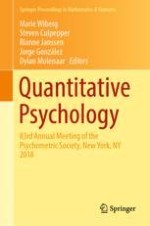2019 | OriginalPaper | Buchkapitel
Model Selection for Monotonic Polynomial Item Response Models
verfasst von : Carl F. Falk
Erschienen in: Quantitative Psychology
Aktivieren Sie unsere intelligente Suche, um passende Fachinhalte oder Patente zu finden.
Wählen Sie Textabschnitte aus um mit Künstlicher Intelligenz passenden Patente zu finden. powered by
Markieren Sie Textabschnitte, um KI-gestützt weitere passende Inhalte zu finden. powered by
